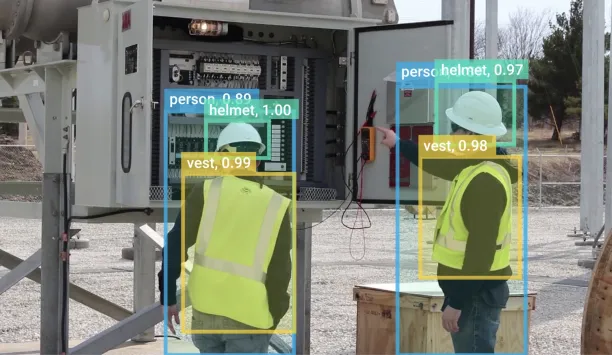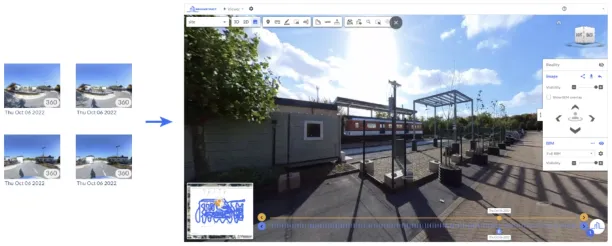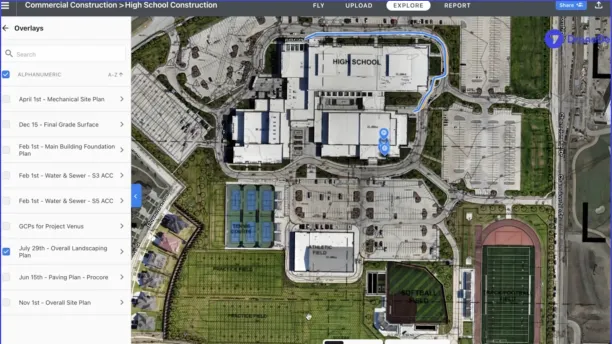Adopting AI technologies, such as computer vision, is accelerating in the construction industry, offering solutions for safety, efficiency, and quality control.
However, challenges like an aging workforce and high-risk tasks continue to hinder widespread implementation.
Explore the top 8 use cases with real-life examples where computer vision construction technologies already impact construction sites. From monitoring worker safety to tracking project progress, these examples highlight how the technology is being applied in real-world settings.
Making construction sites safer
The construction sector involves numerous high-risk tasks, making it one of the most dangerous industries globally, with a consistently high annual fatality rate. As of 2022, nearly one in four (23%) workplace fatalities in the EU occurred within the construction industry.1
Construction managers and business leaders are increasingly adopting innovative solutions to improve safety and ensure compliance with safety protocols on construction sites.
Due to the expansive and dynamic nature of many construction zones, it is often challenging to continuously monitor all areas. Computer vision technology enables real-time monitoring, helping construction companies maintain consistent safety monitoring across the entire project site, ultimately enhancing worker safety and risk management.
1. Personal protective equipment (PPE) compliance
Construction firms are legally and ethically obligated to enforce safety standards, such as:
- Ensuring the use of personal protective equipment (PPE) like helmets, high-visibility jackets, gloves, masks, and safety footwear.
- Enforcing guidelines for the safe operation of construction vehicles, heavy equipment, and construction materials.
- Providing adequate training on safety regulations and workplace safety practices.
However, ensuring full safety compliance in such a complex and fluid environment can be difficult, and non-compliance may lead to serious safety incidents.
Computer vision in construction offers a solution by leveraging deep learning and image recognition to analyze visual data from construction images or live feeds. These AI vision technologies can automatically detect PPE violations and alert site supervisors in real time.
By integrating computer vision systems into daily construction operations, project managers can enhance operational efficiency, prevent potential hazards, and make more informed decisions to support overall project success.

Figure 1: An example of how image recognition works on Personal protective equipment (PPE) detection.2
Real-life example:
YOLOv7 is a real-time object detection model released in 2022 that offers improvements in both accuracy and speed over previous versions. It introduces architectural changes like Extended Efficient Layer Aggregation Networks (E-ELAN) and improved label assignment methods to enhance training and inference.
YOLOv7 can be trained from scratch on small datasets and supports various tasks including instance segmentation. It’s suitable for deployment on both GPUs and edge devices, making it adaptable for a range of technical applications.
In construction industry, YOLOv7 help ensure safety by detecting personnel and equipment.3
2. Hazard detection
Computer vision systems play a critical role in identifying potential hazards on construction sites by providing real-time data and automated alerts. These systems can detect risky areas, unsafe behaviors, or changing conditions during the construction process, helping to prevent accidents and support effective risk management.
For instance, if a heavy container filled with concrete is suspended by a crane, the computer vision technology can use visual data to identify the threat, mark the surrounding zone as hazardous, and immediately alert nearby construction workers and safety officers.
By delivering real-time monitoring and notifications, these computer vision applications help enforce safety protocols, reduce safety risks, and contribute to overall project efficiency and job site safety.
See how it works:
3. Providing safety training
Ensuring workers are adequately trained on safety procedures is a foundational element of construction site safety.
Computer vision can support safety training by capturing visual data from actual site activities and generating video-based learning content. These materials help highlight real incidents and compliance examples, making training sessions more practical and engaging.
Training simulations powered by AI vision systems can also replicate real-world job site conditions, allowing workers to practice responses to high-risk scenarios safely.
Incorporating this approach into safety programs improves knowledge retention and reinforces a culture of safety that complements technology-based monitoring.
Construction automation
Construction automation is rapidly reshaping the construction sector, offering ways to improve project efficiency, reduce manual errors, and enhance worker safety. By integrating computer vision technology with robotics and other smart systems, construction companies can automate a range of tasks that were previously labor-intensive and time-consuming.
4. Robotics in construction
Robotic systems, powered by computer vision algorithms, are now capable of performing tasks such as bricklaying, concrete dispensing, and quality inspection with high precision. These systems can analyze visual data in real time to adapt to their environment, detect potential hazards, and ensure adherence to safety protocols, improving both speed and accuracy on construction projects.
Real-life example:
SAM100 (Semi-Automated Mason) by Construction Robotics is a bricklaying robot that uses computer vision systems to place bricks with precision. It improves laying speed while maintaining consistent alignment and spacing, reducing the burden on human workers in labor-intensive environments.4
5. Autonomous construction vehicles
Self-driving or semi-autonomous construction vehicles—like excavators, bulldozers, and haul trucks—use AI vision technology to navigate complex construction sites safely. Equipped with vision systems, these vehicles can detect obstacles, monitor equipment usage, and optimize routes to reduce downtime, lower fuel costs, and prevent accidents. This enhances both job site safety and asset management.
Real-life example:
Komatsu’s Smart Construction initiative uses drones and autonomous haul trucks equipped with computer vision applications to automate earthmoving operations, improve equipment usage, and enhance site safety through real-time monitoring. See the video below to see it on action.
6. Automated quality control
Maintaining high standards during the construction process is critical. Computer vision in construction supports automated quality control by continuously comparing construction images with digital models or blueprints to identify deviations, structural defects, or improper use of building materials.
These automated inspections reduce the need for manual checks and provide real-time data to inform project planning and decision-making, helping ensure project success.
Reality capture for construction:
Reality capture refers to the use of computer vision technology and advanced imaging tools to document construction sites with high accuracy and detail. By capturing spatial data from the physical environment, construction teams can create accurate digital twins, enabling better project planning, progress tracking, and risk management.
Using tools like laser scanners, drones, and 360° cameras, computer vision systems can capture and process vast amounts of visual data to generate precise 3D models, point clouds, and georeferenced site imagery.
Real-life example:
Reconstruct allows performing reality capture for documenting construction sites using 360-degree cameras.
The process involves planning a capture route, utilizing equipment like hard hat mounts or selfie sticks for stability, and walking through the site to record comprehensive footage. This footage is then processed by Reconstruct’s photogrammetry engine to create a measurable digital twin of the site, allowing stakeholders to review progress, conduct quality control, and compare as-built conditions with design plans.
The method supports integration with additional data sources such as drone imagery and smartphone photos, providing a holistic view of the construction project over time (see figure below).

Figure 2: Step by step description of Reconstruct’s reality capture process.5
Site monitoring
7. 3D mapping of sites
On large or complex project sites, manual inspections can be time-consuming, labor-intensive, and potentially hazardous.
Using high-definition cameras mounted on drones or ground robots, computer vision technology captures construction images and visual data, which are processed with stereo reconstruction algorithms to generate detailed 3D site models.
These digital models allow construction project managers and construction teams to remotely assess the actual progress, identify delays or issues, and make informed decisions—all without the risks and limitations of physical site walkthroughs.
Real-life example:
DroneDeploy provides drone-based 3D mapping and construction monitoring solutions. Their platform uses aerial imagery and AI vision technology to create accurate digital twins of construction zones, enabling teams to track changes over time and detect deviations early in the construction process (see figure below).

Figure 3: DroneDeploy’s construction management software.6
8. Enabling smarter security surveillance
Security is a critical concern on many construction sites, especially those involving sensitive infrastructure such as government buildings, military bases, or high-value commercial developments. These construction projects require controlled access to ensure only authorized personnel and equipment are present on-site.
Computer vision in construction enhances security surveillance by enabling real-time monitoring of entry points, identifying unauthorized individuals, and detecting suspicious activity. Integrated with AI vision technology, these systems can use facial recognition, license plate detection, and behavioral analysis to prevent intrusions and enforce safety protocols across the project site.
Real-life example:
Actuate AI provides a video analytics platform tailored for construction sites, focusing on improving safety and security.
The platform enables real-time detection of threats such as unauthorized access, equipment theft, and safety violations like the absence of hard hats or slip-and-fall incidents. By reducing false positives by over 95%, Actuate’s software allows security teams to respond promptly to genuine incidents, thereby minimizing potential losses and ensuring compliance with safety regulations.7
Conclusion
Computer vision is no longer a futuristic concept in construction—it’s a transformative technology actively reshaping how projects are executed, monitored, and secured.
From enhancing safety through real-time PPE compliance and hazard detection to managing operations via robotics, autonomous vehicles, and automated quality control, these use cases demonstrate the tangible value of AI on modern construction sites.
As companies continue to embrace digital innovation, computer vision stands out as a critical enabler of safer, smarter, and more efficient construction practices.
External Links
- 1. Accidents at work statistics - Statistics Explained - Eurostat.
- 2. Popular applications of computer vision in construction - viso.ai. viso.ai
- 3. YOLOv7: A Powerful Object Detection Algorithm- viso.ai. viso.ai
- 4. SAM - Bricklaying made simpler and safer. - Smart Lifting for Construction and Masonry - Construction Robotics. Construction Robotics
- 5. How to Perform 360 Reality Capture.
- 6. Construction | DroneDeploy.
- 7. Why Construction Site Security Cameras are Essential. Actuate


Comments
Your email address will not be published. All fields are required.